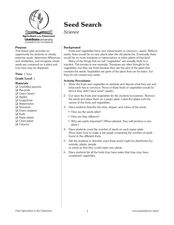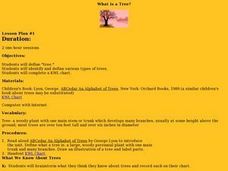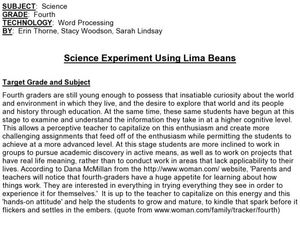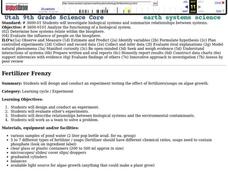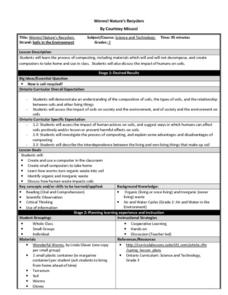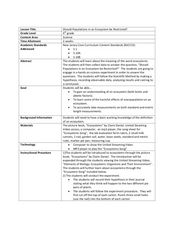Curated OER
The Making of Steel
Students begin to explain the process, and gain an appreciation, of the enormity of a steel facility and the influence it had on the building of the city to run the steel plant. They access websites imbedded in this plan to view the...
Curated OER
Kool Kumara Lesson Plans
Students explore and observe the plant world and acquire knowledge about the functional parts of plants. In this Kool Kumara lesson, students make observations and record specific data on a recording sheet. Students estimation...
Curated OER
Seed Search
First graders examine seeds. In this fruits and vegetables lesson plan, 1st graders determine what fruits and vegetables have in common. Students cut open fruits and vegetables and examine their seeds. Students describe the sizes, shapes...
Curated OER
What is a Tree?
Young scholars identify and define types of trees. In this tree identification lesson, students complete a KWL chart on trees and read the book ABCedar: An Alphabet of Trees. Young scholars complete a tree word scramble.
Curated OER
It's Just Dirt
Students discover how seed germination varies according to the soil type. In this soil science lesson, students discuss what plants need in order to grow and investigate various types of soil. Students use their senses to describe each...
Curated OER
Healthy Eating
A highly informative presentation focuses on healthy diets, food facts, the food pyramid, and healthy eating myths. There is a lot of great information in this PowerPoint, and a really fun interactive component. Perfect for your upper...
Science Friday
Fossil Detectives
What can this rock be? Pupils pretend to be paleontologists by sketching fossils and making predictions about their types. To determine whether they can identify the type of dinosaur, class members compare their observations and...
Education Outside
Seed Saving
After a discussion of the factors that affect seed germination, class groups harvest and preserve seeds from the school garden.
University of Washington
The Carbon Cycle
When it comes to the carbon cycle, the sky really is the limit. The lesson begins with observing a closed ecosystem in a bottle. Then, scholars discuss and answer questions on the carbon dioxide and oxygen cycles.
Curated OER
Mealworms
Crawl into the world of the darkling beetle with this scientific investigation. Watch as the insects move through the larval, pupal, and adult stages of life, recording observations along the way. Discuss the necessities of life as young...
Curated OER
Science Experiment Using Lima Beans
Fourth graders tie together elements about the world and their environment. Students incorporate styles of higher order thinking skills. Students measure skills of observations, conclusions, inferences and predictions.
Curated OER
Ferns and Gymnosperms
In this fern and gymnosperm activity, students will read about two types of vascular tissue: xylem and phloem. Then students will read about the difference between sporophytes and gametophytes. Using this information students will answer...
Curated OER
Tudor Homes- The Still Room and Herb Garden
For this Tudor homes worksheet, students read about the importance of the still room and the herb garden in Tudor life. They locate and identify herbs, sketch a plan of a herb garden at Blakesley Hall, draw an herb, and locate a recipe...
Curated OER
Where in the World?
Students evaluate botany by participating in a class discussion. For this agriculture lesson, students identify the importance of knowing where food comes from and they discuss what their breakfast consisted of and where it came from....
W.K. Kellogg Biological Station
Succession: Patterns in the Field and in Seeds
Have you been wondering how to use that natural trail at or near your school? This activity gets kids outside with a purpose: learn about ecological succession through field observations and collecting seed and soil samples. The resource...
Curated OER
Fertilizer Frenzy
Ninth graders design and conduct an experiment. They evaluate other's experiments. Students describe relationships between biological systems and the environmental contaminants. They work as a team to solve a problem.
Curated OER
Worms, Nature's Recyclers!
Learners study what worms need to survive in different environments. They study how worm composting improves soil and reduce waste. They discuss composting techniques and present a puppet show about a worm's life.
Curated OER
Flower Dissection
Students dissect three different flowers and compare and contrast them. In this flowers lesson plan, students learn about the flower anatomy and then dissect their own flowers.
Curated OER
Animal Signs
Students discuss the many different types of animal signs that can be used to identify and track animals. They participate in an hands-on activity in which they examine tracks, trails, homes, territory markings, and even "scat" left by...
Curated OER
Relationships and Biodiversity Lab
In this relationships and biodiversity worksheet, students investigate the relationships between 4 plants sample using 7 different tests. These include looking at structural characteristics of the plants, seeds and stems, using paper...
Curated OER
Should Populations in an Ecosystem be Restricted?
Fourth graders experiment to determine how overpopulation effects ecosystems specifically plants. In this ecosystem instructional activity, 4th graders conduct an ecosystems experiment after listening to Claire Daniel's, Ecosystems. They...
Curated OER
Plants: Scattering Seeds
Students collect and microscopically examine seeds from the school yard and neighborhood. In small groups, they draw and discuss the shapes of the seeds to determine each plant's method of dispersal. they also test two types of seeds...
Curated OER
Invertebrates
Students examine invertebrates. In this animal classification lesson, students discuss invertebrates and bilateral symmetry. They discuss the importance of horse shoe crabs in medical science.
Curated OER
Graze Like a Cow
Students explore how a cow digests the grass they eat. In this science/math lesson, students compare the quality of forage. Additionally, students determine the effects of rangeland health on the production.


